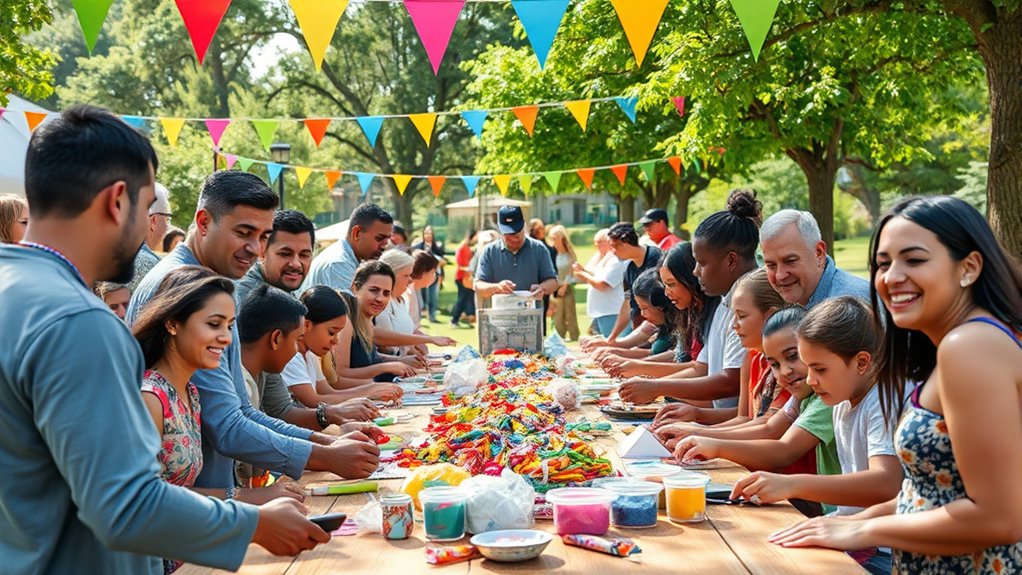To build a community-giving program, start by evaluating local needs and setting clear goals. Engage stakeholders, foster partnerships, and choose diverse funding sources to support your initiatives. Develop effective outreach strategies and design projects that align with community priorities. Monitor progress, measure impact, and celebrate successes to sustain momentum. If you want to learn how to create a lasting, meaningful program, exploring these strategies further will show you the way.
Key Takeaways
- Engage community members, stakeholders, and leaders to gather diverse perspectives and foster trust from the start.
- Define clear, measurable goals aligned with community needs and organizational capacity to guide program development.
- Develop transparent funding strategies, diversify sources, and build strong relationships for program sustainability.
- Tailor outreach and communication efforts to target audiences, utilizing appropriate channels and celebrating participation.
- Monitor project impact through KPIs, gather feedback, and share success stories to promote ongoing growth and community engagement.
Assessing Community Needs and Setting Goals
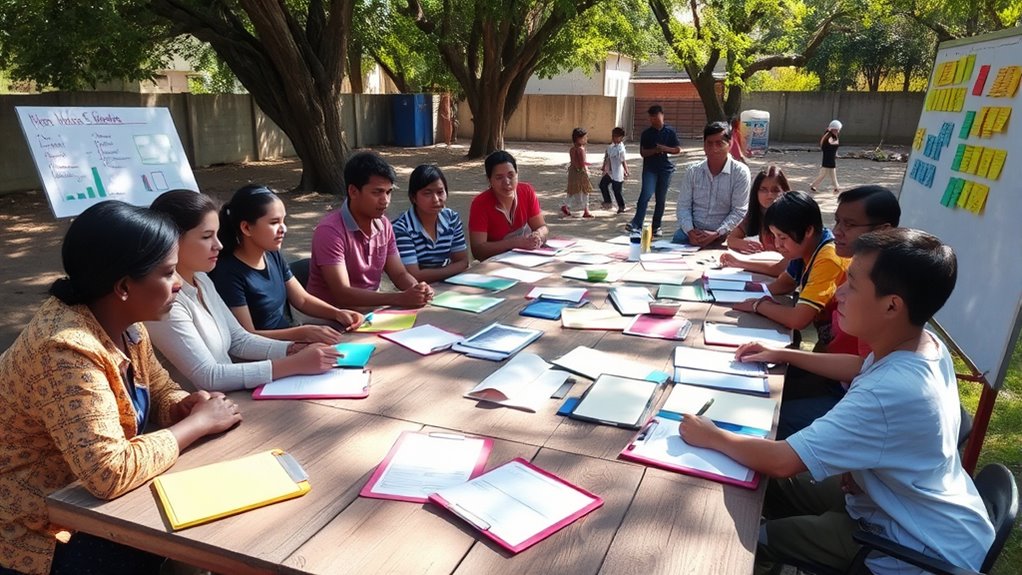
How do you determine what your community truly needs? Start by listening. Talk to local residents, community leaders, and organizations to gather insights about pressing issues. Review existing data, such as surveys, reports, and demographic information, to identify patterns and gaps. Attend community events and forums to hear directly from those affected. Observe the environment, noting areas lacking resources or support. Once you have a clear picture, set specific, measurable goals that address these needs. Prioritize issues based on urgency, impact, and feasibility. Remember, your goals should align with your organization’s capacity and mission. This focused approach ensures your community-giving program makes meaningful, sustainable contributions that genuinely improve lives. Incorporating community feedback and ongoing assessment can help adapt your program to evolving needs.
Engaging Stakeholders and Building Partnerships
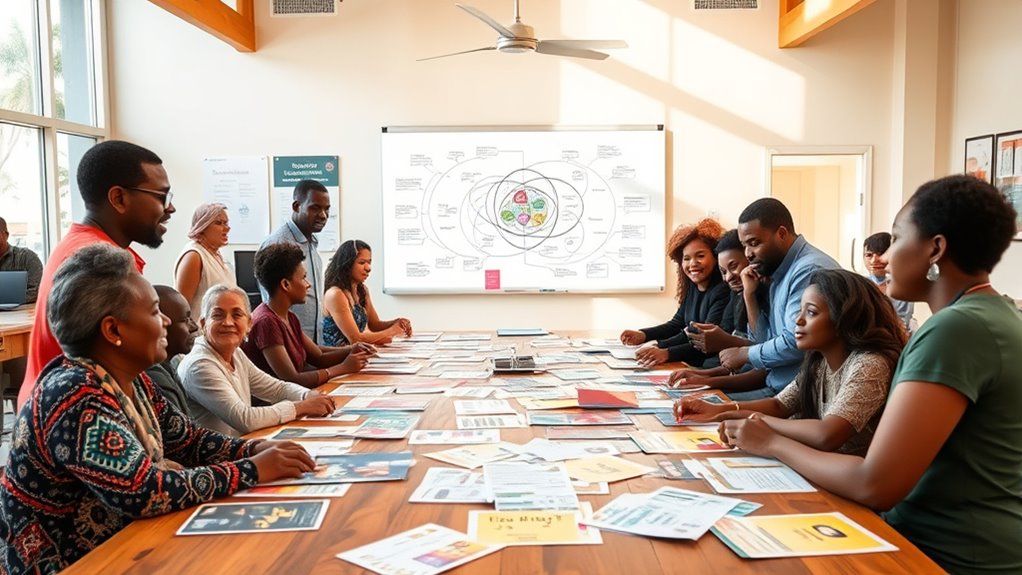
Building strong community relationships and identifying key partners are essential for your program’s success. By engaging stakeholders early, you create a network of support that can help you achieve your goals. Focus on cultivating trust and finding strategic allies who share your vision. Additionally, fostering a culture of empathy and compassion within your community can enhance collaboration and mutual understanding.
Cultivating Community Relationships
Establishing strong community relationships begins with actively engaging stakeholders and forming meaningful partnerships. You should listen to community members’ needs and show genuine interest in their concerns. Attend local events, participate in conversations, and seek feedback regularly. Building trust takes time, so be consistent and transparent in your actions. Collaborate with community groups, local leaders, and residents to create shared goals that benefit everyone. Recognize cultural differences and respect diverse perspectives to foster inclusivity. By demonstrating your commitment to the community’s well-being, you’ll strengthen relationships and encourage ongoing support. Incorporating cultural awareness into your efforts helps deepen trust and understanding. Remember, cultivating these bonds isn’t a one-time effort but a continuous process of communication, collaboration, and genuine engagement. Strong relationships lay the foundation for a successful community-giving program.
Identifying Strategic Partners
Are you ready to identify the right partners to strengthen your community-giving program? Start by mapping out organizations, businesses, and leaders aligned with your mission. Look for partners who share your values and have a genuine interest in community development. Reach out to local nonprofits, schools, faith-based groups, and civic organizations—they often have established networks and resources. Consider their capacity and willingness to collaborate, not just their reputation. Building strong relationships takes time, so be clear about what you can offer and what you seek in return. Engage stakeholders early, listen to their ideas, and find common goals. When you build authentic partnerships, your program gains credibility, expands reach, and creates sustainable impact. Additionally, understanding the impact of technologies like projectors can help in creating engaging presentations to promote your community initiatives.
Designing a Program Structure and Funding Model
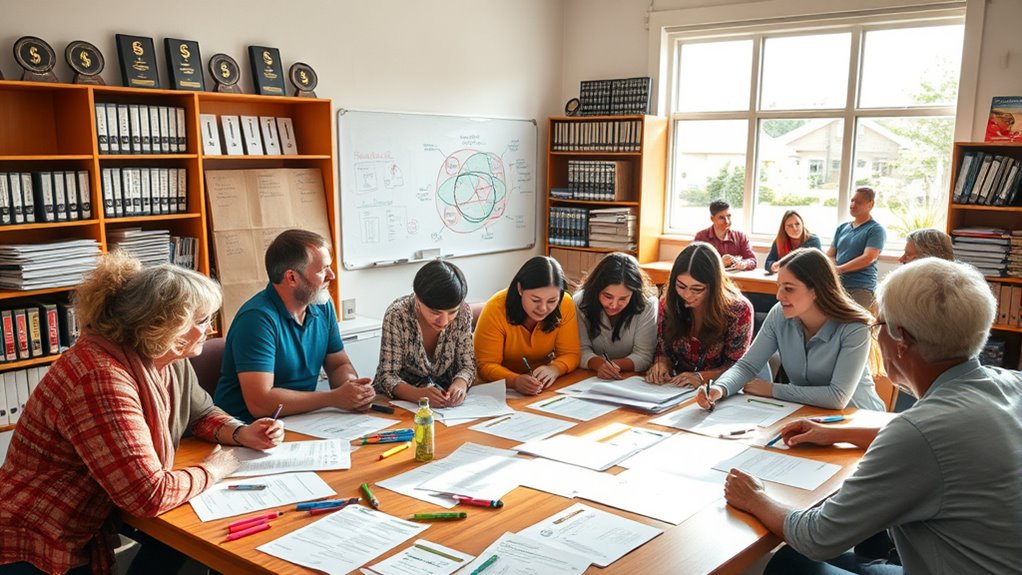
Designing a program structure and funding model requires careful planning to guarantee sustainability and impact. You need to define clear goals and identify how resources will support these objectives. Decide whether your program will operate through grants, donations, or a combination of both, and establish criteria for distributing funds. Consider creating tiers or categories to address different community needs or project sizes. Build flexibility into your model to adapt over time, ensuring ongoing engagement and support. You should also develop a budget plan that accounts for administrative costs, outreach, and evaluation. Transparency in how funds are allocated builds trust and encourages participation. By thoughtfully structuring your program and funding, you lay a solid foundation for meaningful community impact and long-term success.
Developing a Clear Outreach and Communication Plan
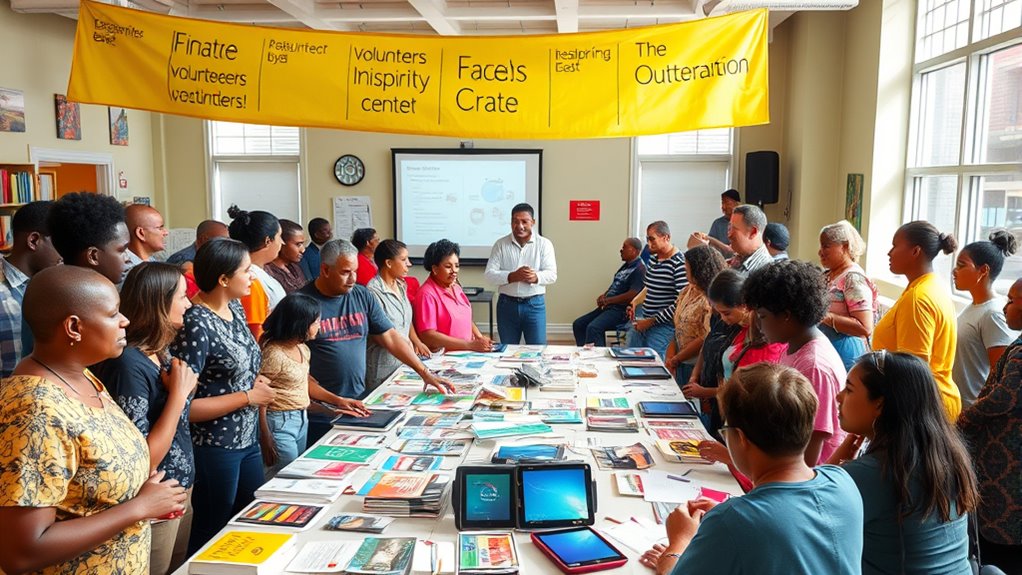
To develop an effective outreach and communication plan, you need to clearly identify your target audience and understand what motivates them. Then, choose communication channels that best reach and engage this group, whether through social media, email, or community events. By focusing on these key points, you guarantee your message resonates and drives participation. Incorporating insights from home decor trends can also help tailor your messaging to align with current aesthetic preferences and styles.
Define Target Audience
How can you guarantee your community-giving program reaches the right people? The key is defining your target audience clearly. Start by identifying the demographics that align with your mission—consider age, location, interests, and needs. Think about who benefits most from your efforts and who can help spread your message. Conduct surveys or gather data to understand their preferences and behaviors. Create detailed profiles or personas that represent your ideal recipients and supporters. This focused approach helps you tailor your outreach efforts effectively, ensuring your resources aren’t wasted on irrelevant groups. Understanding the importance of separation and children can guide your messaging to address specific family needs and challenges. By knowing exactly who you want to engage, you can develop messaging that resonates and builds genuine connections within your community.
Choose Effective Communication Channels
Choosing the right communication channels is essential for effectively reaching your target audience. Start by understanding where your community members spend their time—social media platforms, email, local events, or community boards. Focus on channels that align with your audience’s preferences and habits. Use a mix of digital and traditional methods to maximize outreach. Keep your messages clear, consistent, and compelling across all platforms. Regular updates, engaging visuals, and calls to action encourage participation. Track engagement metrics to see what works best and refine your approach accordingly. Remember, the goal is to build trust and foster genuine connections, so select channels that facilitate two-way communication and feedback. By choosing effective channels, you ensure your message resonates and motivates your community to get involved. Incorporating content sharing strategies can further enhance your outreach efforts and increase community engagement.
Selecting and Managing Community Projects or Initiatives

Selecting and managing community projects requires careful evaluation of potential initiatives to guarantee they align with your organization’s goals and resources. Start by appraising the community’s needs and identifying projects that address those priorities effectively. Consider the scope, budget, and timeline to ensure feasibility and sustainability. Engage stakeholders, including staff and community members, to gather diverse perspectives and foster buy-in. Once you’ve chosen a project, establish clear goals, roles, and expectations. Regularly monitor progress and adjust plans as needed to stay on track. Be transparent with all involved about successes and challenges. Proper management ensures your efforts deliver meaningful impact and build trust within the community, reinforcing your organization’s commitment to positive change. Incorporating specialty expertise can further enhance the effectiveness of your initiatives.
Implementing Volunteer and Employee Engagement Strategies
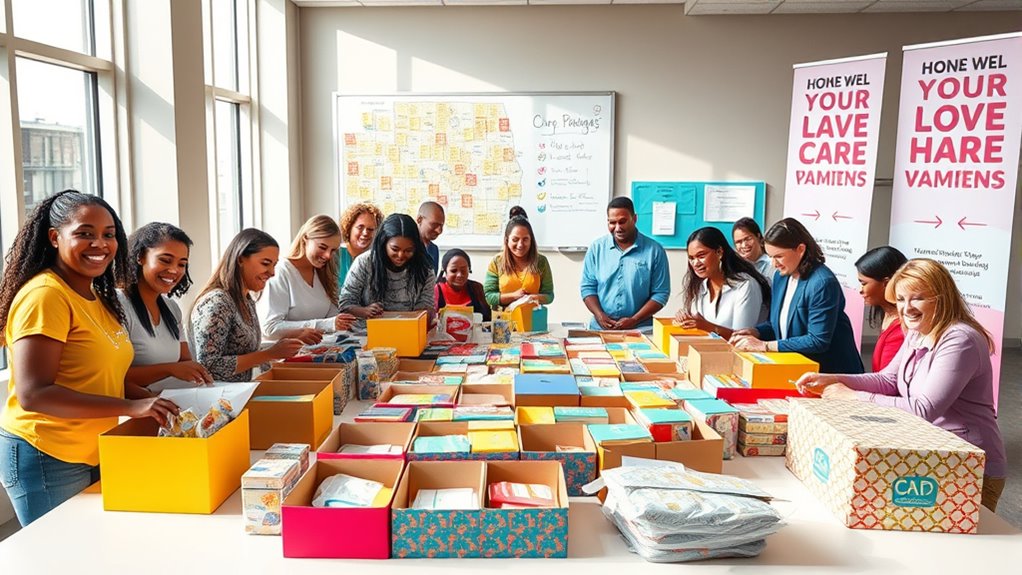
Once community projects are underway, engaging volunteers and employees becomes essential to sustaining momentum and maximizing impact. To do this effectively, communicate clear goals and how each person’s contribution makes a difference. Offer diverse opportunities that match different interests and skill sets, ensuring everyone feels valued and motivated. Recognize and celebrate participation regularly to boost enthusiasm and commitment. Provide training and resources so volunteers and employees feel confident in their roles. Foster a sense of community through team-building activities and open dialogue, encouraging feedback and ideas. By creating a positive, inclusive environment, you’ll enhance engagement and build a dedicated base of supporters who are invested in your program’s success. Engagement isn’t a one-time task—it’s an ongoing effort that nurtures long-term commitment. Incorporating volunteer management strategies can further improve overall participation and satisfaction.
Monitoring Progress and Measuring Impact
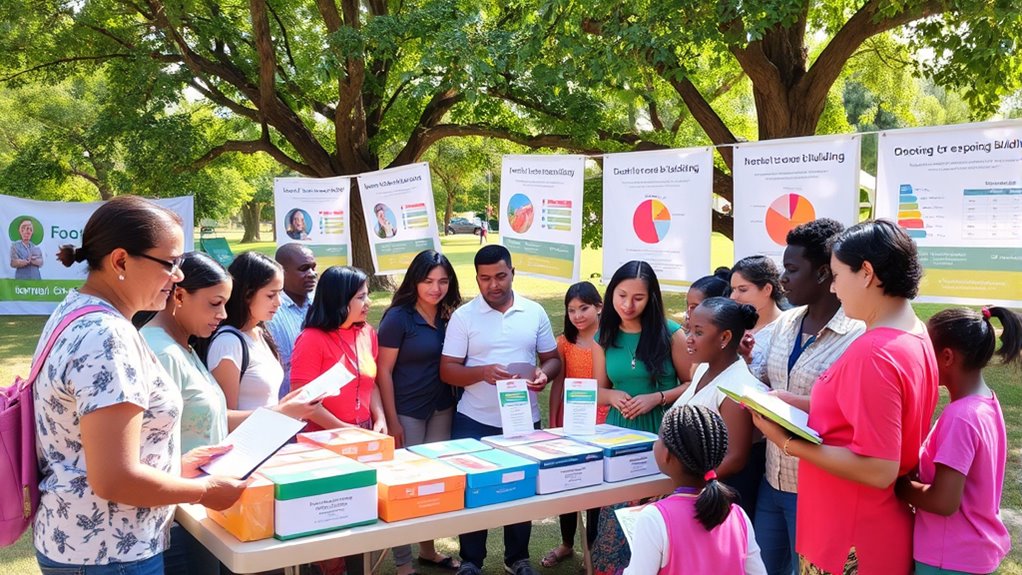
To guarantee your community-giving initiative stays on track and achieves its goals, you need to actively monitor progress and measure impact. Start by setting clear, measurable objectives aligned with your overall mission. Use key performance indicators (KPIs), such as the number of volunteers engaged or funds raised, to track your efforts. Regularly review data and gather feedback from participants and community members to identify what’s working and what needs adjustment. Keep detailed records of activities and outcomes to evaluate your program’s effectiveness over time. This ongoing assessment helps you stay focused, make informed decisions, and demonstrate the value of your contributions. Consistent monitoring ensures your efforts stay aligned with community needs and maximize positive impact. Additionally, understanding vetted products and solutions can help ensure your program utilizes reliable and effective resources.
Ensuring Sustainability and Long-Term Growth
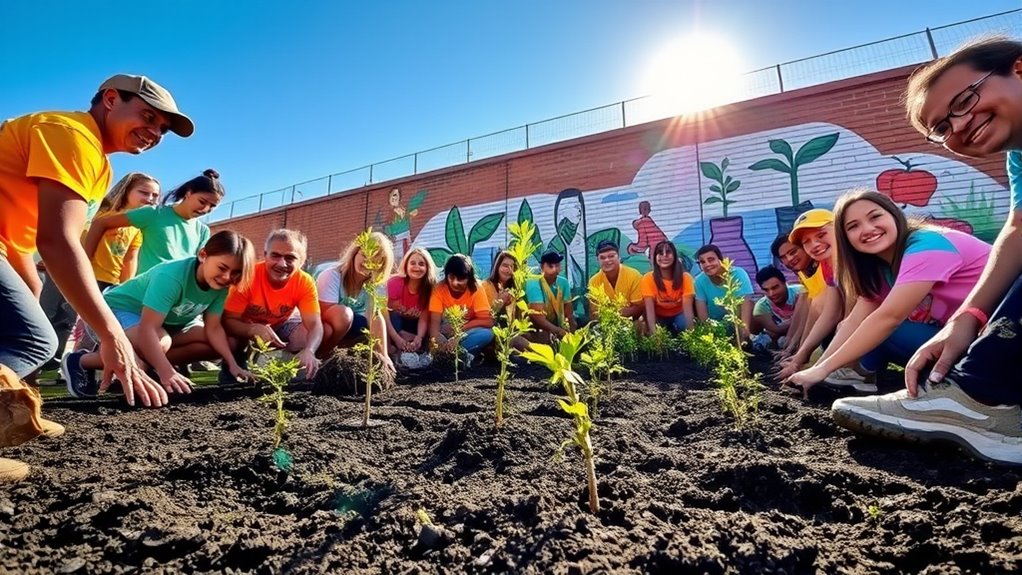
Ensuring your community-giving program’s sustainability and long-term growth requires proactive planning and ongoing commitment. You should establish diversified funding sources, such as grants, individual donations, and corporate partnerships, to reduce reliance on a single stream. Building strong relationships with your community and stakeholders guarantees continued support and engagement. Regularly evaluate your program’s impact to demonstrate value and attract ongoing interest. Creating scalable initiatives allows you to expand gradually without overextending resources. Additionally, invest in leadership development within your team to maintain momentum and adapt to changing needs. Staying adaptable and responsive keeps your program relevant and resilient over time. By actively managing these elements, you set a solid foundation for sustained success and meaningful community impact.
Celebrating Successes and Sharing Stories
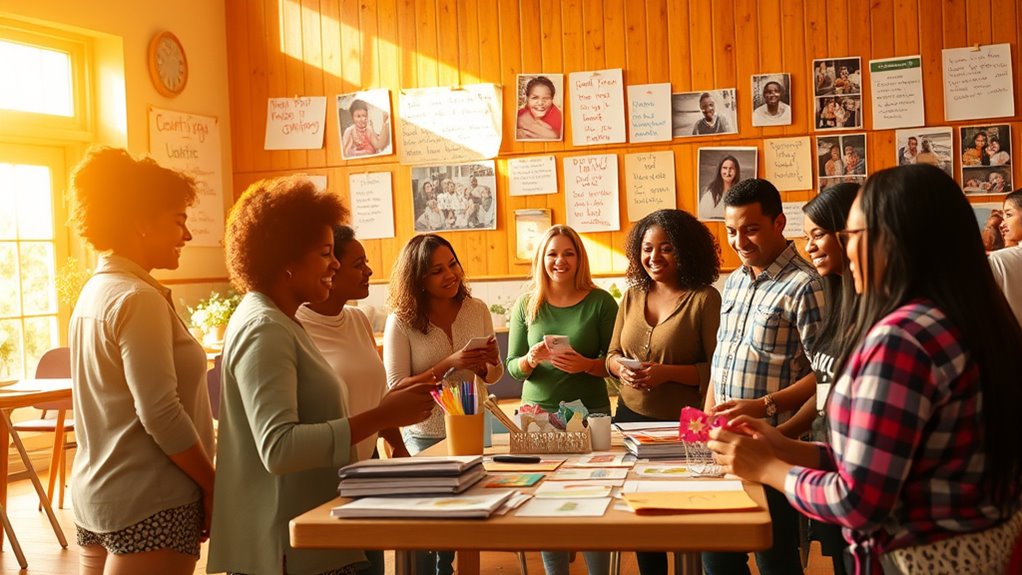
Highlighting your program’s successes and sharing compelling stories can substantially boost ongoing support and engagement. When you showcase real impact, you make your community see the tangible results of their contributions. Use testimonials, case studies, or short videos to bring stories to life. Celebrate milestones publicly through newsletters, social media, or events, and recognize donors and volunteers for their roles. This transparency builds trust and deepens connections. Encourage beneficiaries to share their experiences, creating authentic narratives that resonate with others. When people see the difference their support makes, they’re more likely to stay involved and spread the word. Consistently sharing stories not only highlights achievements but also reinforces your program’s purpose and inspires continued giving.
Frequently Asked Questions
How Can I Secure Initial Funding for the Community-Giving Program?
To secure initial funding, you should start by clearly defining your program’s goals and impact. Then, identify potential funders like local businesses, grants, and individual donors who align with your mission. Craft compelling proposals that highlight community benefits and demonstrate your program’s sustainability. Reach out confidently, build relationships, and leverage social media to raise awareness. Don’t forget to showcase early successes to encourage ongoing support.
What Legal Considerations Should I Be Aware of When Launching the Program?
They say, “Better safe than sorry,” and that’s true here. When launching your program, you need to check local laws on charitable activities, tax regulations, and nonprofit registration. Draft clear policies to avoid legal pitfalls, and consider consulting a lawyer to guarantee compliance. Protect yourself and your community by understanding liability issues, privacy laws, and reporting requirements, so your program runs smoothly and ethically from the start.
How Do I Effectively Resolve Conflicts Among Stakeholders or Partners?
When conflicts arise among stakeholders or partners, you should address them promptly and openly. Listen carefully to each side’s concerns, and facilitate a calm, respectful discussion to find common ground. Clearly communicate your goals and expectations, and seek mutually beneficial solutions. If needed, involve a neutral mediator to help resolve issues. Consistently maintaining transparency and fostering trust will help you manage conflicts effectively and strengthen your relationships.
What Are Common Challenges Faced During Program Implementation?
During program implementation, you often face challenges like resource constraints, which can delay progress, and miscommunication, leading to misunderstandings. You might also encounter resistance from stakeholders hesitant to change or adopt new ideas. Additionally, maintaining engagement and motivation over time can be tough. To overcome these issues, you need clear planning, open communication, flexibility, and strong leadership to keep everyone aligned and committed throughout the process.
How Can I Measure Long-Term Community Impact Beyond Immediate Results?
Imagine your efforts as planting seeds in a vast garden; to measure long-term impact, track how those seeds grow over time. You can do this by monitoring sustained engagement, tracking community improvements, and gathering feedback through surveys and stories. Keep an eye on changes in local well-being and resilience. These indicators act as sunlight and water, revealing how your work nurtures lasting growth beyond immediate results.
Conclusion
By weaving your efforts into the fabric of the community, you’ll create a tapestry of impact that endures. Keep your vision vibrant, your partnerships strong, and your commitment unwavering. As you celebrate each milestone, remember you’re planting seeds that will blossom into lasting change. Your dedication fuels this collective journey, turning small acts into a powerful movement. Together, you’ll build a community giving program that shines brightly, guiding others to follow your inspiring lead.
